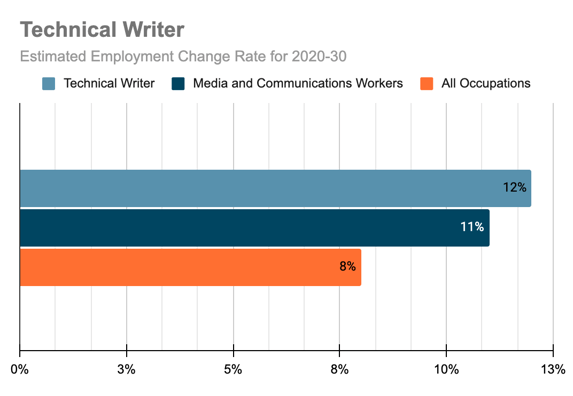Share this
All About Technical Writing for Beginners
by Jin on Aug 18, 2022 8:30:00 AM
Contents
- What is Technical Writing
- Technical Writing vs. Ordinary Writing
- Things to Consider Before Writing
- Process of Writing
- 10 Strategies for Good Technical Writing
- Apply in Practice

The importance of technical writing is constantly being mentioned. What are the reasons?
An Example
During the progression phase, the standby step guides the approver (leader) to the status before approval, In progress, step means the status of the primary approver (leader) from approval until the finalizer. Approval guides the approver (a leader or a deputy) to complete the authorization.
An Example (After Revision)
The progression stage is divided into the following steps:
- Stand by: Status before the approver (leader) approves:
- In progress: The status from the approval of the primary authorizer until the finalizer
- Approval: Approval has been granted by the approver (a leader or a deputy)
Both examples deliver the same message. Which one is easier to read, the original or the revised one? The ‘progression stage’ includes the ‘order’ of processing work, so it is more clear and easier to understand what is divided in order than in a form of lines. Technical writing improves readability and understanding through document standardization and style decisions based on product and reader understanding. It also improves the skill of structuring the content you want to deliver, as shown in the example above.
Now that we realize the importance of technical writing, let's take a closer look at technical writing.
1. What is Technical Writing?
Technical writing, in a narrow sense, refers to the technology of writing documents to accurately and effectively deliver scientific and technical information. In a broad sense, it's not just about delivering scientific and technological information, but also about writing that delivers all types of writing.
According to the Bureau of Labor Statistics, the employment of technical writers is expected to grow 12% from 2020 to 2030, faster than the average for all occupations.
 Source: U.S. Bureau of Labor Statistics, Employment Outlook Program
Source: U.S. Bureau of Labor Statistics, Employment Outlook Program
2. Technical Writing vs. Ordinary Writing
Unlike ordinary writing, technical writing aims to convey useful and accurate information to the reader in an easy-to-understand manner. Examples of technical writing include business documents such as presentations, reports, manuals, resumes, articles, company introductions, analysis reports, renewal of apps, websites, translation reviews, and job and business writing education.
Unlike novels and essays, technical writing is a business-related documentation technique, so you should avoid ambiguous explanations and clearly state them so that readers can understand them easily. You should also convey facts based on valid information, not subjective thoughts or speculations.
3. Things to Consider Before Writing
It is important to identify the reader before writing the content in earnest. The difficulty of terms and content should be adjusted according to the reader's background knowledge, and the content should be written in consideration of the reader's purpose of reading. In addition, you can improve the reader's understanding by using idioms and expressions suitable for the reader's culture and native language.
Considerations for identifying the reader include:
- Who is the Reader?
- What is the reader's goal and why are they reading this document?
- What does the reader already know before reading the document?
- What should the reader know or be able to do after reading the document?
4. Process of Writing
Once the topic has been selected and the reader has been identified, it is necessary to understand the process of technical writing. The process of technical writing can be divided into five stages: planning, structuring, writing, revision, and distribution.
1) Planning
Determine the topic, publishing schedule, and channels of the document, and identify the appropriate templates and styles for the document you want to write. Then collect the information related to the topic and keep track of its progress. After the project is completed, you will have a documentation timeline and guidelines for the output you will get.
2) Structuring
Create a table of contents so that readers can see what you want to convey at a glance.
3) Writing
Organize the relevant information based on the table of contents and write the document in earnest. Additional information should be obtained through research when writing content, and if you have any ambiguity or questions, you should write them down separately and verify the facts.
4) Revision
Gather opinions on the draft of any stakeholders or related experts. Use this process to make up for deficiencies and correct them to verify the facts. After modifying the content, double-check the spelling and typos to make the final version.
5) Distribution
The final version will be distributed according to the date of issue set early in the planning stage. If it is a timely document that requires continuous management, it may modify its contents after distribution.
5. 10 Strategies for Good Technical Writing
1) Fully understand the reader’s background knowledge and culture in advance.2) Investigate similar content and analyze the features.
3) Adopt the effective means of information method according to the reader.
4) Use concise sentences.
5) Add additional explanations on terms that are difficult to understand.
6) Clarify the information that the reader will eventually get.
7) Leverage design elements that enhance understanding of content.
8) If the information is time sensitive, specify when it is created or the relevant date.
9) Review the content with third parties before distribution.
10) Regularly modify and update published content.
6. Apply in Practice
Technical writing can be applied in a variety of areas. Among them, business-to-business (B2B) marketing has a great effect. As B2B marketing is a concept that encompasses marketing strategies and content, it refers to a marketing strategy used by companies that sell products or services to other companies or organizations.
Unlike B2C customers who are relatively responsive to emotional content and entertainment, B2B customers value logic and ROI, so they are eager to focus on expertise and to be trained. In addition, as they purchase items from the corporate perspective, it focuses on information that accurately tells the product's functionality and differentiation in making decisions.
Therefore, high customer conversion rates can be achieved easily by conveying professional information that potential customers may be interested in using technical writing. Before that, for potential customers to find our carefully crafted content on the Internet, you will have to develop and implement appropriate SEO strategies.